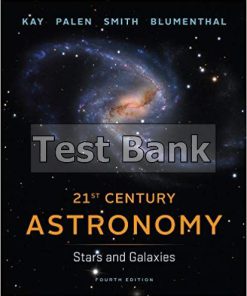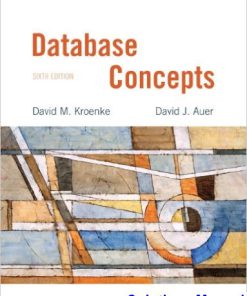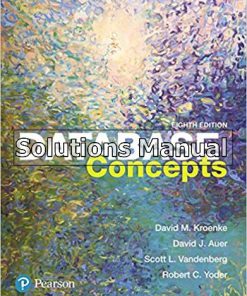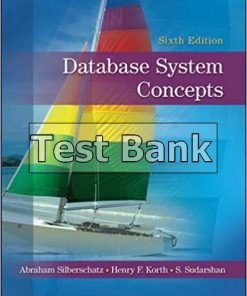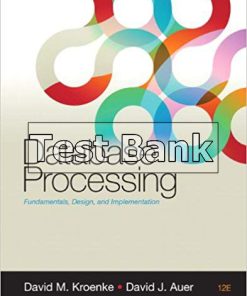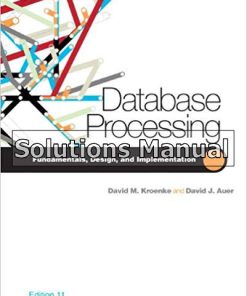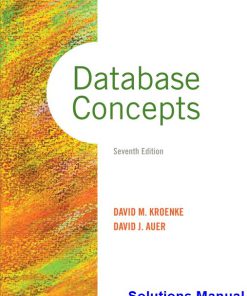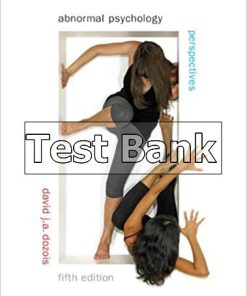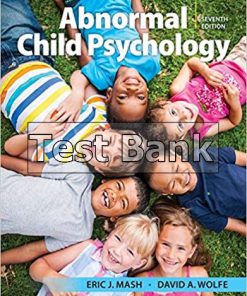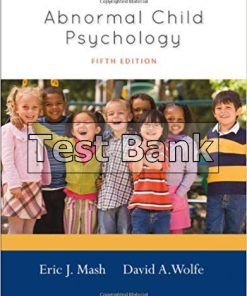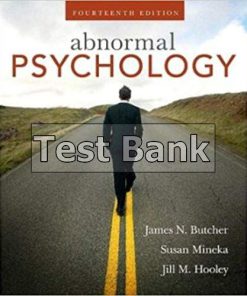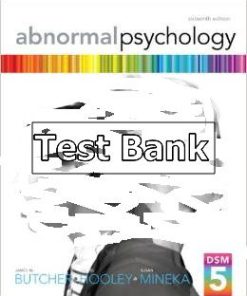-
1 × $26.99
-
1 × $26.99
-
1 × $26.99
-
1 × $26.99
-
1 × $26.99
-
1 × $26.99
-
1 × $26.99
-
1 × $26.99
-
1 × $26.99
-
1 × $26.99
-
American Stories A History of the United States Combined Volume 1 and 2 1st Edition Brands Test Bank1 × $26.99
-
1 × $26.99
-
1 × $26.99
Database Concepts 6th Edition Kroenke Test Bank
You may also like
Database Concepts 6th Edition Kroenke Test Bank
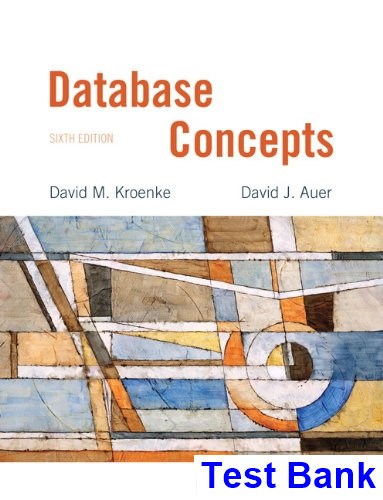
Product details:
- ISBN-10 : 0132742926
- ISBN-13 : 978-0132742924
- Author:
Written by two of the world’s leading database authorities, Database Concepts introduces the essential concepts students need to create and use small databases. Instructor’s Review Copy This textbook consists of eight chapters and 10 online appendices chapter 1 explains why databases Are used, what their components are, and how they are developed. Students: the purpose of databases and their applications as well as how databases differ from and improve on lists and spreadsheets
Table contents:
Chapter 1 Introduction 1.1 Database System Applications 1 1.2 Database Systems versus File Systems 3 1.3 View of Data 5 1.4 Data Models 7 1.5 Database Languages 11 1.6 Database Users and Administrators 13 1.7 Transaction Management 15 1.8 Database System Structure 16 1.9 Application Architectures 18 1.10 History of Database Systems 18 1.11 Summary 21 Exercises 23 Bibliographical Notes 24 PART 1 DATA MODELS Chapter 2 Entity-Relationship Model 2.1 Basic Concepts 27 2.2 Constraints 33 2.3 Keys 35 2.4 Design Issues 37 2.5 Entity-Relationship Diagram 42 2.6 Weak Entity Sets 47 2.7 Extended E-R Features 49 2.8 Design of an E-R Database Schema 56 2.9 Reduction of an E-R Schema to Tables 62 2.10 The Unified Modeling Language UML 68 2.11 Summary 70 Exercises 72 Bibliographical Notes 77 Chapter 3 Relational Model 3.1 Structure of Relational Databases 79 3.2 The Relational Algebra 89 3.3 Extended Relational-Algebra Operations 103 3.4 Modification of the Database 111 3.5 Views 113 3.6 The Tuple Relational Calculus 118 3.7 The Domain Relational Calculus 122 3.8 Summary 126 Exercises 127 Bibliographical Notes 131 PART 2 RELATIONAL DATABASES Chapter 4 SQL 4.1 Background 135 4.2 Basic Structure 137 4.3 Set Operations 144 4.4 Aggregate Functions 146 4.5 Null Values 148 4.6 Nested Subqueries 149 4.7 Views 154 4.8 Complex Queries 155 4.9 Modification of the Database 157 4.10 Joined Relations 163 4.11 Data-Definition Language 168 4.12 Embedded SQL 172 4.13 Dynamic SQL 175 4.14 Other SQL Features 180 4.15 Summary 182 Exercises 183 Bibliographical Notes 186 Chapter 5 Other Relational Languages 5.1 Query-by-Example 189 5.2 Datalog 203 5.3 User Interfaces and Tools 217 5.4 Summary 219 Exercises 220 Bibliographical Notes 223 Chapter 6 Integrity and Security 6.1 Domain Constraints 225 6.2 Referential Integrity 227 6.3 Assertions 232 6.4 Triggers 233 6.5 Security and Authorization 238 6.6 Authorization in SQL 244 6.7 Encryption and Authentication 248 6.8 Summary 250 Exercises 252 Bibliographical Notes 254 Chapter 7 Relational-Database Design 7.1 First Normal Form 257 7.2 Pitfalls in Relational-Database Design 258 7.3 Functional Dependencies 260 7.4 Decomposition 271 7.5 Desirable Properties of Decomposition 275 7.6 Boyce-Codd Normal Form 279 7.7 Third Normal Form 284 7.8 Fourth Normal Form 289 7.9 More Normal Forms 293 7.10 Overall Database Design Process 293 7.11 Summary 297 Exercises 299 Bibliographical Notes 303 PART 3 OBJECT-BASED DATABASES AND XML Chapter 8 Object-Oriented Databases 8.1 Need for Complex Data Types 307 8.2 The Object-Oriented Data Model 308 8.3 Object-Oriented Languages 318 8.4 Persistent Programming Languages 318 8.5 Persistent C++ Systems 322 8.6 Persistent Java Systems 330 8.7 Summary 331 Exercises 332 Bibliographical Notes 333 Chapter 9 Object-Relational Databases 9.1 Nested Relations 335 9.2 Complex Types 337 9.3 Inheritance 342 9.4 Reference Types 346 9.5 Querying with Complex Types 348 9.6 Functions and Procedures 351 9.7 Object-Oriented versus Object-Relational 356 9.8 Summary 357 Exercises 358 Bibliographical Notes 360 Chapter 10 XML 10.1 Background 361 10.2 Structure of XML Data 364 10.3 XML Document Schema 367 10.4 Querying and Transformation 372 10.5 The Application Program Interface 380 10.6 Storage of XML Data 381 10.7 XML Applications 384 10.8 Summary 386 Exercises 388 Bibliographical Notes 390 PART 4 DATA STORAGE AND QUERYING Chapter 11 Storage and File Structure 11.1 Overview of Physical Storage Media 393 11.2 Magnetic Disks 396 11.3 RAID 402 11.4 Tertiary Storage 410 11.5 Storage Access 412 11.6 File Organization 415 11.7 Organization of Records in Files 422 11.8 Data-Dictionary Storage 426 11.9 Storage for Object-Oriented Databases 428 11.10 Summary 438 Exercises 440 Bibliographical Notes 443 Chapter 12 Indexing and Hashing 12.1 Basic Concepts 445 12.2 Ordered Indices 446 12.3 B+-Tree Index Files 453 12.4 B-Tree Index Files 464 12.5 Static Hashing 465 12.6 Dynamic Hashing 471 12.7 Comparison of Ordered Indexing and Hashing 477 12.8 Index Definition in SQL 479 12.9 Multiple-Key Access 480 12.10 Summary 487 Exercises 489 Bibliographical Notes 491 Chapter 13 Query Processing 13.1 Overview 493 13.2 Measures of Query Cost 495 13.3 Selection Operation 496 13.4 Sorting 501 13.5 Join Operation 503 13.6 Other Operations 514 13.7 Evaluation of Expressions 518 13.8 Summary 523 Exercises 525 Bibliographical Notes 526 Chapter 14 Query Optimization 14.1 Overview 529 14.2 Estimating Statistics of Expression Results 531 14.3 Transformation of Relational Expressions 537 14.4 Choice of Evaluation Plans 544 14.5 Materialized Views 553 14.6 Summary 557 Exercises 559 Bibliographical Notes 561 PART 5 TRANSACTIONMANAGEMENT Chapter 15 Transactions 15.1 Transaction Concept 565 15.2 Transaction State 568 15.3 Implementation of Atomicity and Durability 571 15.4 Concurrent Executions 573 15.5 Serializability 576 15.6 Recoverability 582 15.7 Implementation of Isolation 583 15.8 Transaction Definition in SQL 584 15.9 Testing for Serializability 584 15.10 Summary 586 Exercises 588 Bibliographical Notes 590 Chapter 16 Concurrency Control 16.1 Lock-Based Protocols 591 16.2 Timestamp-Based Protocols 604 16.3 Validation-Based Protocols 607 16.4 Multiple Granularity 609 16.5 Multiversion Schemes 612 16.6 Deadlock Handling 615 16.7 Insert and Delete Operations 620 16.8 Weak Levels of Consistency 623 16.9 Concurrency in Index Structures 625 16.10 Summary 629 Exercises 632 Bibliographical Notes 636 Chapter 17 Recovery System 17.1 Failure Classification 639 17.2 Storage Structure 640 17.3 Recovery and Atomicity 644 17.4 Log-Based Recovery 645 17.5 Shadow Paging 653 17.6 Recovery with Concurrent Transactions 657 17.7 Buffer Management 660 17.8 Failure with Loss of Nonvolatile Storage 663 17.9 Advanced Recovery Techniques 664 17.10 Remote Backup Systems 672 17.11 Summary 674 Exercises 677 Bibliographical Notes 679 PART 6 DATABASE SYSTEM ARCHITECTURE Chapter 18 Database System Architectures 18.1 Centralized and Client-Server Architectures 683 18.2 Server System Architectures 687 18.3 Parallel Systems 691 18.4 Distributed Systems 697 18.5 Network Types 701 18.6 Summary 703 Exercises 705 Bibliographical Notes 707 Chapter 19 Distributed Databases 19.1 Homogeneous and Heterogeneous Databases 709 19.2 Distributed Data Storage 710 19.3 Distributed Transactions 713 19.4 Commit Protocols 716 19.5 Concurrency Control in Distributed Databases 722 19.6 Availability 730 19.7 Distributed Query Processing 735 19.8 Heterogeneous Distributed Databases 738 19.9 Directory Systems 741 19.10 Summary 746 Exercises 749 Bibliographical Notes 752 Chapter 20 Parallel Databases 20.1 Introduction 755 20.2 I/O Parallelism 756 20.3 Interquery Parallelism 760 20.4 Intraquery Parallelism 761 20.5 Intraoperation Parallelism 762 20.6 Interoperation Parallelism 770 20.7 Design of Parallel Systems 772 20.8 Summary 773 Exercises 775 Bibliographical Notes 777 PART 7 OTHER TOPICS Chapter 21 Application Development and Administration 21.1 Web Interfaces to Databases 781 21.2 Performance Tuning 790 21.3 Performance Benchmarks 798 21.4 Standardization 802 21.5 E-Commerce 806 21.6 Legacy Systems 809 21.7 Summary 810 Exercises 812 Bibliographical Notes 815 Chapter 22 Advanced Querying and Information Retrieval 22.1 Decision-Support Systems 817 22.2 Data Analysis and OLAP 819 22.3 Data Mining 830 22.4 Data Warehousing 842 22.5 Information-Retrieval Systems 846 22.6 Summary 856 Exercises 859 Bibliographical Notes 861 Chapter 23 Advanced Data Types and New Applications 23.1 Motivation 863 23.2 Time in Databases 864 23.3 Spatial and Geographic Data 866 23.4 Multimedia Databases 877 23.5 Mobility and Personal Databases 880 23.6 Summary 885 Exercises 887 Bibliographical Notes 889 Chapter 24 Advanced Transaction Processing 24.1 Transaction-Processing Monitors 891 24.2 Transactional Workflows 895 24.3 Main-Memory Databases 901 24.4 Real-Time Transaction Systems 903 24.5 Long-Duration Transactions 904 24.6 Transaction Management in Multidatabases 910 24.7 Summary 914 Exercises 916 Bibliographical Notes 917 PART 8 CASE STUDIES Chapter 25 Oracle 25.1 Database Design and Querying Tools 921 25.2 SQL Variations and Extensions 923 25.3 Storage and Indexing 925 25.4 Query Processing and Optimization 934 25.5 Concurrency Control and Recovery 940 25.6 System Architecture 942 25.7 Replication, Distribution, and External Data 945 25.8 Database Administration Tools 946 Bibliographical Notes 947 Chapter 26 IBM DB2 Universal Database 26.1 Database Design and Querying Tools 950 26.2 SQL Variations and Extensions 951 26.3 Storage and Indexing 953 26.4 Query Processing and Optimization 956 26.5 Concurrency Control and Recovery 960 26.6 System Architecture 963 26.7 Replication, Distribution, and External Data 965 26.8 Database Administration Tools 965 26.9 Summary 967 Bibliographical Notes 967 Chapter 27 Microsoft SQL Server 27.1 Management, Design, and Querying Tools 969 27.2 SQL Variations and Extensions 975 27.3 Storage and Indexing 980 27.4 Query Processing and Optimization 982 27.5 Concurrency and Recovery 986 27.6 System Architecture 991 27.7 Data Access 992 27.8 Distribution and Replication 994 27.9 Full-Text Queries on Relational Data 998 27.10 Data Warehousing and Analysis Services 999 27.11 XML and Web Support 1002 27.12 Summary 1005 Bibliographical Notes 1005 PART 9 APPENDICES Appendix A Network Model (contents online) A.1 Basic Concepts A1 A.2 Data-Structure Diagrams A2 A.3 The DBTG CODASYL Model A7 A.4 DBTG Data-Retrieval Facility A13 A.5 DBTG Update Facility A20 A.6 DBTG Set-Processing Facility A22 A.7 Mapping of Networks to Files A27 A.8 Summary A31 Exercises A32 Bibliographical Notes A35 Appendix B Hierarchical Model (contents online) B.1 Basic Concepts B1 B.2 Tree-Structure Diagrams B2 B.3 Data-Retrieval Facility B13 B.4 Update Facility B18 B.5 Virtual Records B21 B.6 Mapping of Hierarchies to Files B22 B.7 The IMS Database System B24 B.8 Summary B25 Exercises B26 Bibliographical Notes B29 Appendix C Advanced Relational Design (contents online) C.1 Multivalued Dependencies C1 C.2 Join Dependencies C5 C.3 Domain-Key Normal Form C8 C.4 Summary C10 Exercises C10 Bibliographical Notes C11 Bibliography 1007 Index 1043
People also search:
database system concepts 6th edition solution to exercises
database system concepts 6th edition slides
what are the basic concepts of database
what is database concepts
important database concepts
database concepts and types





